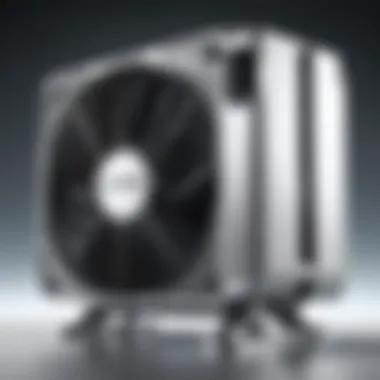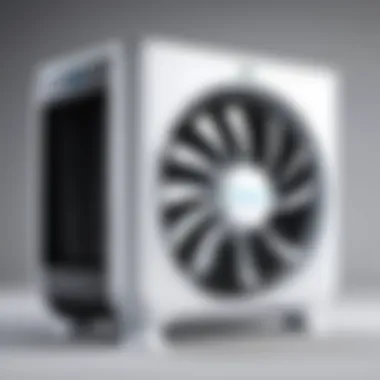Comprehensive Guide to Air Cooler Ratings and Reviews


Intro
Air coolers, in recent years, have gained significant traction as an effective method for maintaining comfortable indoor temperatures without the hefty energy bills associated with traditional air conditioning systems.
These devices, which often rely on evaporation principles, offer an intriguing blend of efficiency and sustainability, making them increasingly appealing to consumers in various climates. But with an array of models flooding the market, how does one distinguish between the stars and the duds? This is where a deep dive into air cooler ratings comes into play.
Understanding ratings helps consumers grasp not just the cooling capabilities, but also factors like energy consumption, durability, and noise levels. Moreover, user feedback paints a vivid picture of how these coolers perform in real-world conditions.
By taking a closer look at the metrics that matter, readers can arm themselves with the knowledge needed for making informed purchases aligned with their specific needs.
An informed choice in air cooling solutions can lead to enhanced comfort, lower environmental impact, and increased satisfaction. So, buckle up as we embark on this comprehensive evaluation of air cooler ratings.
Understanding Air Coolers
Air coolers have become indispensable in many homes, especially as summer heat waves descend, turning our surroundings into saunas. Understanding air coolers is crucial for anyone looking to improve indoor comfort while being mindful of energy consumption and costs. In this article, we’ll break down how these devices work, their features, and the varieties that exist, so you can make informed decisions.
When it comes to air coolers, knowing the basics helps. These devices aren’t just fans—they actively cool the air through the process of evaporation. This means they take warm air, draw it over water-saturated pads, and release a refreshing breeze. This simple yet effective mechanism is a major benefit during hot, dry conditions.
The importance of understanding air coolers also lies in recognizing that not one size fits all. With a variety of options, from portable units to window-mounted models, each type suits different needs and environments. For instance, a portable cooler may be perfect for smaller spaces or temporary setups, while window air coolers are more suited for permanent placements.
Choosing the right air cooler involves weighing factors like efficiency, noise levels, and cooling capacity. Understanding these elements can guide consumers toward selecting a model that not only meets their cooling needs but also fits seamlessly into their living space and lifestyle.
What Is an Air Cooler?
An air cooler, at its core, is a device designed to lower the temperature of the air in a space. Unlike traditional air conditioning units, air coolers rely on the natural process of evaporation to cool the air. The principal function of an air cooler includes drawing in hot, dry air, passing it through water-saturated pads, and then expelling cooler air back into the room. This method is particularly effective in dry climates where humidity levels are low.
Air coolers are often viewed as an energy-efficient alternative to air conditioning, using significantly less power. This not only reflects in lowered utility bills, but also aligns with a growing preference for eco-friendly solutions.
Types of Air Coolers
Evaporative Air Coolers
Evaporative air coolers are often touted for their simplicity and efficiency. These units work by drawing in hot air and passing it through water-saturated filters, where the evaporation process takes place.
Key Characteristic: One primary feature of evaporative coolers is their reliance on natural processes, making them environmentally friendly.
Unique Feature: They not only cool the air but also add moisture to it, which can be beneficial in dry climates where humidity is lacking.
However, it's essential to note that while they do cool the air effectively, the humidity added can create discomfort in already humid conditions. This dual impact gives them a niche appeal but limits their effectiveness in some environments.
Portable Air Coolers
Portable air coolers offer flexibility for those who need cooling on the go. These units are designed to be moved easily from room to room, providing a personal cooling option.
Key Characteristic: The compact nature of portable coolers makes them a popular choice for small spaces or temporary setups, such as dorm rooms and offices.
Unique Feature: Many portable coolers come equipped with wheels and an easy-fill water tank, making them user-friendly and convenient.
However, portable air coolers can struggle to cool larger spaces effectively, so it's vital for buyers to consider room size when choosing this option.
Window Air Coolers
Window air coolers are more permanent solutions that are typically installed in a window frame. They provide a steady cooling option for specific areas of a home.
Key Characteristic: Their installation allows them to exhaust hot air outside, which enhances their cooling performance compared to other types.
Unique Feature: Many models come with adjustable fan speeds and thermostats to customize settings based on user preferences.


Despite their effectiveness, window air coolers can block natural light and obstruct views, which for some people, can be a detriment.
Understanding these types of air coolers can illuminate the path toward making the best choice for one's cooling needs, ultimately leading to greater satisfaction with the purchase.
Key Features to Consider
When it comes to choosing the right air cooler, understanding the key features is essential. Not all air coolers are created equally, and overlooking important aspects can lead to dissatisfaction and discomfort. The features you consider can significantly affect the efficiency, cost, and overall functionality of the device. By diving into the critical components of air coolers, you can sift through the noise and focus on what truly matters. The main elements to keep in mind include cooling capacity, energy efficiency, and noise levels.
Cooling Capacity
Understanding BTU Ratings
Cooling capacity fundamentally influences an air cooler's effectiveness. The British Thermal Unit (BTU) rating indicates how much heat an air cooler can remove from a space within an hour. Generally, a higher BTU means better cooling potential. If you're kneed-deep in a scorching summer, choosing an air cooler with a suitable BTU rating can be the saving grace.
However, it's crucial to match BTUs with your space size. For example, an air cooler rated for high BTUs in a small room could turn it into an icebox, wasting energy and money. Thus, evaluating BTU is not just important; it becomes the linchpin of effective cooling.
Room Size Considerations
Determining your room size before making a purchase can feel like a daunting task—similar to navigating a maze without a map. But it’s indispensable. Room size directly correlates to the air cooler's cooling range. Too small a cooler in a big room will struggle to keep the temp bearable, while a large one in a compact space may blast chill so harsh you’ll need a blanket.
Think about the layout too, as corners, furniture, and other structures can influence airflow. Ensuring your air cooler is well-suited for the actual room dimensions makes a substantial difference in its performance.
Energy Efficiency
Evaluating EER Ratings
Energy Efficiency Ratio (EER) ratings shed light on an air cooler's energy consumption relative to its cooling capability. A quick glance at the EER will tell you how efficiently a unit uses electricity to perform its work. A higher EER means you're less likely to get a nasty surprise when the electricity bill arrives.
Affordable cooling may tempt you, but skimping on EER could cost you in the long run. The EER helps in striking a balance between comfort and energy costs. For example, an air cooler may exhibit great cooling but at the cost of energy efficiency, which can lead to hefty charges.
Impacts of Energy Consumption
Understanding how energy consumption affects your wallet is key. Unlike traditional air conditioning systems, air coolers typically consume less power, but being oblivious to energy consumption can still keep you scrambling for cash. Being aware of the operational costs of an air cooler can temper your expectations.
A well-calibrated air cooler intelligently uses energy depending on its environment and settings, which can save you a pretty penny. Also, consider models with smart features that adjust power based on outdoor temperatures or humidity levels.
Noise Levels
Decibel Ratings Explained
Noise levels are an often-overlooked feature when picking out an air cooler. Decibel ratings provide a clue into how loud or quiet a unit operates. For peace-loving individuals, picking a model with lower decibel ratings is like striking gold.
Most of us can remember a time where we opted for cool air only to be kept awake by a guttural roar from the cooler. Taking note of decible ratings prevents those sleepless nights and fosters a more tranquil atmosphere.
Comparing Quiet Models
A wise consumer should sort through the differences in noise levels between models before making a decision. Quiet air coolers usually have well-designed fans or insulating materials to minimize noise, creating an environment that is both refreshing and calm.
In a purchase scenario, run-of-the-mill units may be significantly less pricey, but trading off quality for quantity can yield dissatisfaction. The late-night gaming sessions or unwinding with a movie calls for a cooler that knows how to keep its mouth shut while delivering optimal comfort.
Takeaway: When evaluating air coolers, scrutinizing their key features such as cooling capacity, energy efficiency, and noise levels will guide you to a choice that aligns with your needs, ensuring comfort without compromise.
Top Air Cooler Brands
When it comes to choosing an air cooler, understanding the top brands in the market is critical. These brands not only set standards in cooling technology but also influence user expectations in terms of performance, customer service, and reliability. Each of these top-tier brands has carved out a niche through consistent quality, innovation, and positive user experiences, making them the go-to references in evaluating air cooler ratings. By examining their unique offerings, potential buyers can make well-informed choices tailored to their cooling needs.
Brand A Overview
Model Variants


Brand A has a diverse lineup of air cooler models, each tailored to meet different consumer needs. This variety allows customers to select a model that fits their specific environment, be it a small room or a larger space. A highlight of Brand A’s model variants is their adaptability features; they come equipped with adjustable fan speeds and oscillation options, ensuring a bespoke cooling experience. One standout model is the UltraCool 3000, which offers an electrostatic filter and a timer function, appealing to tech-savvy users looking for advanced air purification. However, some models have been noted to consume more power than expected, giving consumers pause when considering long-term energy costs.
User Feedback
The user feedback for Brand A has been generally positive, primarily due to its ease of use and effective cooling performance. Consumers appreciate the sleek design and relatively quiet operation, making it a practical choice for home and office settings alike. An interesting aspect of the feedback is the brand's ability to maintain relatively high ratings across various social media platforms and online review sites. The only downside reported seems to be a lag in customer service response times, which can become an issue if repairs are needed. Nevertheless, the product quality largely compensates for this inconvenience.
Brand B Overview
Design Innovations
Brand B has made significant strides in design innovations, focusing on modern aesthetics combined with functional performance. Their air coolers feature a minimalist look that can blend seamlessly into contemporary settings. One distinguishing characteristic is the SmartTouch interface, allowing users to control settings via a mobile application, giving users a sense of having tech at their fingertips. This innovation has drawn in a younger audience that value both form and function. However, despite these advancements, some users have raised concerns about connectivity issues with the app, potentially hindering the overall user experience.
Performance Ratings
When dissecting performance ratings, Brand B consistently receives marks for its outstanding cooling capacity and energy efficiency. The HiFiCool 2000 model, for instance, has a high EER rating, illustrating that it provides substantial cooling for lower energy consumption. Users have lauded Brand B’s models for their reliability and durability. However, it’s worth noting that while the upfront cost can be higher compared to competitors, the long-term savings in energy bills may justify the investment for eco-conscious buyers.
Brand Overview
Unique Selling Propositions
Brand C stands out with its unique selling propositions, primarily focusing on environmentally friendly materials and energy-efficient technology. The EcoChill series is marketed as a green alternative, utilizing natural refrigerants and recycled components in its construction. This commitment to sustainability has resonated with environmentally-conscious consumers. On the flip side, the focus on eco-friendliness sometimes leads to a limited selection in terms of performance features compared to more traditional designs.
Market Position
In terms of market position, Brand C has successfully established a strong presence, particularly amongst those who value sustainability over sheer power. Its marketing strategy effectively highlights its dedication to green practices while offering a solid performance. However, challenges arise due to stiff competition from brands with longstanding reputations for performance and customer service. Despite this, Brand C continues to carve its niche and attract users who prefer responsible consumption practices.
User Experiences and Reviews
Understanding the real-world application of air coolers often hinges on the opinions and reviews of users who have already tested these products in various environments. This section dives into the significance of user experiences and how they help inform potential buyers about the practicality and functionality of different air cooler models.
People rely heavily on the feedback from others who have faced similar challenges. The firsthand experiences shared through user reviews can provide insight into not only the performance but also the quirks and unanticipated issues that may not be evident through traditional marketing channels.
Gathering Consumer Feedback
Online Review Platforms
Online review platforms are critical in today’s digital age for obtaining unbiased feedback from consumers. These platforms, like Reddit and Facebook, offer a wealth of information where users can engage and share their thoughts about specific models. A unique quality of these platforms is the ability to read a range of reviews, from detailed descriptions of performance to brief summaries of user satisfaction.
What makes online review platforms particularly beneficial is that they allow consumers to ask questions and get answers directly from other users. This back-and-forth can clarify concerns about certain features or troubleshooting issues. However, the downside is that the sheer volume of reviews can overwhelm potential buyers, making it challenging to discern the most relevant information for a specific need.
Social Media Insights
Similarly, social media insights play a pivotal role in shaping consumer perceptions and trends in air cooler usage. Platforms such as Facebook and Twitter allow users to share immediate experiences, promotions, and tips on maintenance and troubleshooting. It's an informal network where real-life testimonials can be gathered quickly.
One standout characteristic is the engagement factor; users often reply to posts or follow threads that discuss specific brands. These insights can be invaluable. On the flip side, since social media tends to amplify vocal opinions, it could lead to a skewed perception based on either overly enthusiastic or negative feedback.
Analyzing Common Complaints
Functionality Issues
Functional issues are prevalent complaints that often surface in user reviews and deserve attention. Analyzing these concerns provides potential purchasers with a realistic expectation of what to expect from their chosen model. Common functionality complaints may involve inadequate cooling capacity or overly complex operation settings.
The key here is identifying these issues early on, as they can indicate a poorly designed product or an overwhelming set of features that are not user-friendly. Pinpointing frequent complaints can aid in avoiding costly mistakes when making a purchase.
Customer Service Experiences
Customer service experiences often significantly impact both satisfaction and brand loyalty. Users frequently comment on how brands handle their concerns, warranty claims, or troubleshooting inquiries. In the realm of air coolers, swift and effective customer service can either enhance or diminish a buyer’s overall impression of a product.
A unique aspect of customer service feedback is that it can reveal the brand's commitment to supporting its products—a crucial factor when you consider that an air cooler may have a lifespan of several years. On the downside, negative customer service experiences can overshadow otherwise great product features, leading to a lack of trust in the brand itself.


"User feedback not only highlights the strengths of a product but also unveils areas that may need improvement."
Delving into user experiences and reviews provides value beyond marketing claims, offering potential buyers a multi-faceted view of the air coolers on the market.
Performance Ratings and Comparisons
When it comes to choosing an air cooler, performance ratings and comparisons play a pivotal role in making an informed decision. They provide potential buyers with the necessary insights to evaluate the effectiveness of different models, ensuring that the one selected meets specific cooling needs. Understanding these metrics allows for a more judicious investment, minimizing the risk of dissatisfaction post-purchase. Performance ratings often encompass various criteria, including cooling speed and durability, which we will delve into further. Here’s why this segment is not just a luxury but a necessity for any savvy buyer.
Performance Benchmarks
Cooling Speed
Cooling speed is a crucial element that showcases how quickly an air cooler can lower the temperature in a given space. This aspect is particularly vital for those living in scorching climates or for situations where an immediate cooling effect is desired, like during gaming marathons or intense study sessions.
One key characteristic of cooling speed is its correlation with airflow rate, often measured in CFM (cubic feet per minute). A higher airflow rate generally indicates faster cooling. Popular models tend to maintain a balance between airflow and energy efficiency, making them appealing for both eco-conscious buyers and those looking for rapid relief from heat.
A standout feature of cooling speed is how it can also affect comfort levels within an environment. A cooler that ramps up quickly can prevent overheating in densely populated areas, enhancing both user experience and productivity. However, the trade-off might be increased noise levels, a factor to consider when selecting the right model.
Durability Assessments
Durability assessments examine how well an air cooler can withstand regular wear and tear over time, which is essential for ensuring long-term satisfaction with the product. The ability to last through seasonal usage cycles without significant breakdowns is a hallmark of quality in any air cooling unit.
A vital aspect of durability is the quality of materials used in construction. Many reliable models utilize corrosion-resistant components or reinforced housing, making them favorable choices for consumers looking for longevity. This can save buyers from the headaches associated with frequent repairs or replacements, ultimately proving economical in the long run.
Unique to durability assessments is also the warranty period offered by manufacturers. A longer warranty often indicates the brand's confidence in their product, which can greatly influence buyer decision-making. Yet, it's practical to remember that the highest durability doesn't guarantee the lowest maintenance or operational costs; those can vary significantly.
Comparison of Best Models
Feature-by-Feature Comparison
Feature-by-feature comparison is an instrumental strategy for scrutinizing air coolers as it breaks down the myriad of specifications into digestible information. It's about holding each model up to the light, examining their features side by side, particularly for essential elements such as energy efficiency, noise levels, and design.
The key characteristic of this approach is its detailed nature, allowing users to make nuanced distinctions. For example, a model with a higher energy efficiency rating could result in substantial savings on electricity bills in the long term, thus appealing to budget-minded consumers, while high decibel ratings could deter those sensitive to noise.
A unique benefit of feature-by-feature comparison lies in its capacity to empower buyers to find the right balance between price and features, ensuring they don't overspend on bells and whistles they might not need. However, confusion may arise if the comparison gets overly technical, especially for individuals less familiar with specifications.
Price Performance Ratios
Price performance ratios serve as an analytic lens to examine the cost-effectiveness of various air coolers. This metric essentially assesses the price point of an air cooler against its cooling performance and associated features, providing a clear view of value for money.
The key characteristic here is its straightforwardness. By breaking down how much cooling power each dollar buys, prospective buyers can easily determine which models offer the best bang for their buck. This can be especially beneficial in the crowded market, helping the discerning buyer sift through the noise.
One unique aspect of price performance ratios is that they often highlight discrepancies that may not be immediately apparent, such as a less expensive model outperforming a pricier competitor in terms of reliability or energy consumption. Conversely, it's worth acknowledging that sometimes, models might have a lower initial price but come with hidden costs—like higher maintenance or operating expenses—that could skew their true performance value.
Ending and Recommendations
In any discussion about air coolers, reaching a strong conclusion is necessary. It’s not just about numbers on a spreadsheet or metrics thrown around casually. It’s about giving clarity to users who might feel overwhelmed by the selection out there. Understanding how to interpret air cooler ratings can lead someone to the right purchase, ultimately enhancing their comfort in hot weather.
The emphasis here lies heavily on summarizing the critical insights gathered from previous sections. For instance, the performance ratings, user feedback, and unique features of different brands provide a solid background for making informed decisions. If you keep in mind the energy efficiency and noise levels, you can find an air cooler that not only keeps your space chill but also aids in lowering electricity bills and offering a peaceful environment.
Additionally, considering the practical implications of each rating can make a substantial difference. For example, if a cooler has a high cooling capacity but low energy efficiency, the operational costs may outweigh its benefits in the long run. Recognizing such nuances allows potential buyers to navigate the marketplace more smartly.
Summarizing Key Findings
Across various discussions, several crucial points continually rise to the forefront:
- Performance Metrics: Metrics like BTU ratings and energy efficiency ratios play significant roles in determining how well an air cooler can maintain a comfortable space.
- User Experiences: Consumers often share insights on ease of use, maintenance, and long-term satisfaction. Real-world feedback provides context that raw data may not capture.
- Critical Features: Quiet operation and portability have become essential factors. With many people working from home, the need for an unobtrusive air cooler has grown.
These findings coalesce to form a clear picture. By recognizing the changing needs and evolving technology, customers can choose a model that suits their lifestyle.
Final Thoughts on Air Coolers
In wrapping up, it's essential to reiterate that selecting the right air cooler isn’t a trivial decision. As temperatures fluctuate and personal preferences vary, knowing what options are available and how to evaluate them becomes paramount. As technology improves, we can expect continual upgrades in efficiency and design, affecting future ratings and consumer choices.
The market is vast, but with a critical eye on performance and functionality, finding a model that aligns with individual needs is possible. Moreover, it's a journey—a continuous exploration of what’s out there, driven by user feedback and performance ratings. So, take the plunge, assess your requirements, and dive into what the realm of air coolers has to offer.



